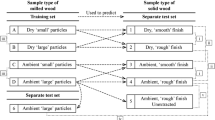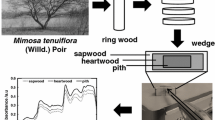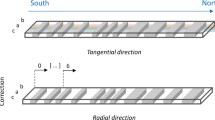Abstract
This work was undertaken to investigate the feasibility of using near infrared spectroscopy (NIR) and partial least squares regression (PLS) as a tool to characterize the basic wood properties of Norway Spruce (Picea abies (L.) Karst.). The wood samples originated from a trial located in the province of Västerbotten in Sweden. In this trial, the effects of birch shelterwoods (Betula pendula Roth) of different densities on growth and yield in Norway spruce understorey were examined. All Norway spruce trees in each shelterwood treatment were divided into three growth rate classes based on diameter at breast height (1.3 m) over bark. Five discs were cut from each tree (i.e. from the root stem, and at 20%, 40%, 60%, and 80% of the total height). The discs from 40% tree height were used (i.e., where the largest variations in annual ring widths and wood density were found). A total of 27 discs were selected. The discs were used for measuring annual ring widths, wood density, average fiber length and the fiber length distributions. Milled wood samples prepared from the discs were used for recording NIR spectra. PLS regression was used to generate prediction models for the wood properties (Y-matrix) and NIR spectra (X-matrix) as well as between the wood properties (Y-matrix) and the fiber length distributions (X-matrix). One set of models was generated using untreated spectra and fiber length distributions. For a second set of models the structure in the X-matrix, which was orthogonal to the matrix described by the wood properties, was eliminated using a soft target rotation technique called orthogonal signal correction (OSC). The PLS model obtained using “raw” untreated NIR spectra and fiber length distributions had a poor modeling power as evidenced by the cumulative Q2 values. For the PLS models based on untreated NIR spectra the cumulative Q2 values ranged from a minimum of 16% (wood density) to a maximum of 46% (no. of annual rings). Orthogonal signal correction of the X-matrix (NIR spectra or fiber length distributions) gave PLS models with a modeling power corresponding to cumulative Q2 values well in excess of 70%. The improvement in predictive ability accomplished by the OSC procedure was verified by placing four of the 27 observations in an external test set and comparing RMSEP values for the test set observations without OSC and with OSC.
Similar content being viewed by others
Author information
Authors and Affiliations
Additional information
Received 12 June 1999
Rights and permissions
About this article
Cite this article
Hauksson, J., Bergqvist, G., Bergsten, U. et al. Prediction of basic wood properties for Norway spruce. Interpretation of Near Infrared Spectroscopy data using partial least squares regression. Wood Science and Technology 35, 475–485 (2001). https://doi.org/10.1007/s00226-001-0123-3
Issue Date:
DOI: https://doi.org/10.1007/s00226-001-0123-3




